Apr 13, 2025
Apr 13, 2025
During Christmas holidays (2003), my family and I went to India for a short vacation. Apart from our hometown Mangalore, we also visited New Delhi and Agra as well as Calicut in Kerala.
I found India a resurgent country. This was not the country I left decades ago nor was it the one I used to visit regularly. There seemed to be a distinct change since I visited here only three years ago. People for the most part are happier and one can see progress everywhere. The economic tide is rising and all the boats are lifted. Gone are the days of failed experiments in socialism. Indians have embraced capitalism with open arms. They have also become extremely competitive in the world markets. The label 'Made in India' is proudly displayed. This is not to say the problems of crumbling infrastructure are all gone but there is an awareness and determination to make improvements. People also realize that this will take time but the trend is in the right direction.
I spent three weeks in India, mostly as a tourist. This is an account my trip, with some anecdotes, and my observations and impressions of India in general.
The Cricketers Dared, a Despot Snared
As expected it was a long and arduous journey. The way to combat fatigue and boredom in a long flight is to be resigned to its inevitability. If one is mentally prepared to the tediousness of it before one steps on the plane, the ordeal becomes more tolerable. The only thrill during the flight was to read in a BBC newsflash that the despot Saddam Hussein was ferreted out of his hole in the ground. My co-passengers took the news in stride and if they had any emotions no one bothered to show it. Incidentally, the capture of Saddam Hussein took place as our plane was flying over the Middle Eastern air (perhaps over Baghdad).
India seemed to beckon with open arms, in all her glory - and shortcomings. My first foot on the soil of India gave me a feeling of thrill and rush. I had to spend a lot of time in the wee hours of the morning in Mumbai airport. Like the old name of Bombay it has shed, the city has made an attempt to improve facilities in the waiting lounges of the airport. The second test cricket match between India and Australia was projected on a large television, which was being watched by everyone in the airport. India was chasing a mammoth first innings total of 556 runs by the Aussies and Rahul Dravid was playing a gallant innings with a knock of a double century. (India eventually won the match, a crowning achievement ' I was told).
The efficiency of Indian authorities in the airport struck me as something different from my previous experiences. The processing in the immigration and customs was definitely a breeze, compared to yesteryears. I was also amazed at the ability of the people to spot the NRI's (a prefix to my name since I left India). However much I tried to blend in, I could not shed this image of being an outsider (foreign-returned is the term used), in my own country. My attempts to be an Indian were always shattered when the baggage handlers or the hotel boys or the guides treated me differently (always expecting a fatter tip.) Even the attendants of the Jet Airways coach (a courtesy service that takes one from the domestic airport to the international airport), expected money from the NRI's. This asking for tips was despite the fact that they had shirts displaying, in bold letters, 'Courtesy Service ' NO TIPS PLEASE'. When I questioned the attendant he brushed it aside and said that the words printed on his shirt were meant for people who could not read!
To Manipal or Bust
After flying out of Mumbai to Mangalore, one of the objectives of my trip was to attend the golden jubilee celebrations in Manipal, Karnataka. This is my old medical school, which has quickly become an educational institution of repute. Every subset of professional education is available here. Apart from the usual courses in medicine, engineering, nursing, pharmacy etc., there are many rare opportunities for students to pursue training in hotel management, catering school and even poultry farming. The campus originally built on a barren hill three miles from Udipi, has now been transformed into a lush green mega university complex, comparable to any in the world.
I got a little carried away and let my guard down during lunch and dinner on that eventful day. As an occasional visitor to India, I had learned long ago that my stoic stomach had lost its immunity against that bug that makes the stomach queasy. Sure enough I spent the next two days in bed with frequent trips to the adjacent bathroom. I quickly started myself on antibiotics, hydration and 'bowel binders.' The result was as swift and I was back on my feet in two days. The fever abated and the Montezuma's curse lifted. However, I was unable to attend the final two days of the meeting in Manipal, a disappointment indeed. But such are the vicissitudes of life!
On to the Capital
My schedule was very tight. Our children were to join us in Delhi, as the two boys and a friend were to come a week after I had landed. Delhi is reputed to be densely foggy in the winter months and the flights were routinely delayed or even diverted. As we had only two weeks in India to do a month' worth of traveling, you perhaps can sense my unease.
We reached Delhi in a flight from Mangalore to Mumbai without a hitch. And it was not fog or nature's wrath that delayed our sons and their friend. Unbelievably it was an incident far more embarrassing and ludicrous. The Virgin Atlantic Airlines never left Washington D. C. that evening as the pilot was inebriated and was in no position to fly. There were no spare pilots and while the incidence made a big flash in the evening news, the passengers had to spend a night in Washington D.C. and board another flight next morning. Fortunately, there was no fog in Delhi when they landed safely. Whether Virgin Atlantic had to wait till next morning so that the pilot had to be sober enough to fly again is a question I never found an answer to!
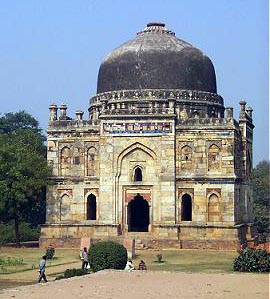 We mixed sightseeing with shopping in Delhi. An early morning walk through the Lodi gardens was a first for me. The air was crisp and the light that filtered through a thin layer of fog was heavenly. Above all, it was clean and refreshing.
We mixed sightseeing with shopping in Delhi. An early morning walk through the Lodi gardens was a first for me. The air was crisp and the light that filtered through a thin layer of fog was heavenly. Above all, it was clean and refreshing.
The garden was built by Sikander Lodi and Ibrahim Lodi in the 15th century.
Lodi was the last dynasty before the Mughal rule in India was established by Babar. The garden is sprinkled with tombs, mostly built with slabs of red stones, with unmarked graves. The interior mosaic of tiles and rich red, blue and gold paint on the ceiling and walls are in disrepair but the glory of the rulers of Delhi, even before the Mughals is evident, as seen in the cupolas of the Qutb Minar.
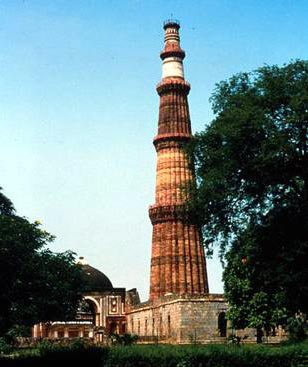 We confined our sightseeing in Delhi to only the Qutb Minar and Humayun's tomb due to constraints of time. Qutb Minar, built late 12th century, by the slave king Qutb ud din Aibak, in the wake of the assault of Muhammad of Ghor on North India. (He was a slave warrior in the Ghor army from Afghanistan, and had fought beside Muhammad. To him Muhammad bequeathed the conquered lands of North India. Qutb Minar is one of the earliest Muslim architectures in India. It also exemplifies the intolerance of Islam towards the idolatry of Hinduism as the surrounding buildings show pillars with defaced carvings of Hindu gods. Temple destruction, which was a sport for many rulers of Delhi, was especially true of Qutb ud din Aibak. The stone pillars pillaged from surrounding temples were put to good use here, in a colonnaded hall on one side of Qutb Minar.
We confined our sightseeing in Delhi to only the Qutb Minar and Humayun's tomb due to constraints of time. Qutb Minar, built late 12th century, by the slave king Qutb ud din Aibak, in the wake of the assault of Muhammad of Ghor on North India. (He was a slave warrior in the Ghor army from Afghanistan, and had fought beside Muhammad. To him Muhammad bequeathed the conquered lands of North India. Qutb Minar is one of the earliest Muslim architectures in India. It also exemplifies the intolerance of Islam towards the idolatry of Hinduism as the surrounding buildings show pillars with defaced carvings of Hindu gods. Temple destruction, which was a sport for many rulers of Delhi, was especially true of Qutb ud din Aibak. The stone pillars pillaged from surrounding temples were put to good use here, in a colonnaded hall on one side of Qutb Minar.
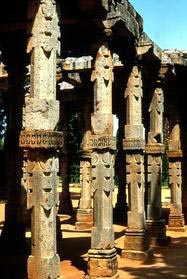
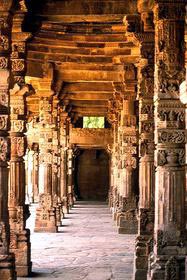
This checkered history of its construction does not take anything away from the glory of the minar with its five tiered balconies. Various repairs of the tower had been done by subsequent sultans of Delhi (it was even hit and damaged by lightning strike and later repaired, and the top most cupola fell during an earthquake as late as the early nineteenth century).
A doorway here with rich, fine architecture built by the notorious Alauddin Khilji brought back memories of the sword-wielding sultan of early fourteenth century.
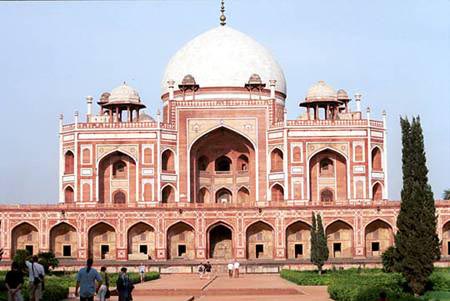
Humayun’s tomb (father of Akbar) has been cleaned up since I had seen it last. The gardens are well groomed and this precursor to the Taj Mahal is well preserved. Gone are the bats and their stench. (During my last visit - about ten years ago – I remember my feeling of sadness, seeing the state of negligence of this glorious building). Akbar’s mother had personally supervised the construction of the tomb that lasted several years. The tomb is an architectural triumph and first of its kind built with the help of Persian architects. The surrounding grounds are vast and well preserved now. There are so many gravesites here that the building is called the ‘gathering place of the dead’. There is even a gravesite with a building for the barber, who must have served the Mughals well during his lifetime!
It was interesting to see the graves of the three sons of Shah Jahan, who were murdered by their brother, Aurangzeb. These unmarked graves, built of ordinary limestone are on the periphery of the platform on which Humayun’s tomb is built They lie there naked without a shelter, and exposed to the elements. An inglorious end, particularly to the oldest son of Shah Jahan, called Dara Shikoh. He had shown traits and demeanor of his great grandfather, Emperor Akbar. Like Akbar, Dara Shikoh had an affinity and tolerance to other religions and was a follower of Sufi saints (as compared to his intolerant brother Aurangzeb, who was a strict orthodox Muslim). He had even studied the Upanishads and translated them to Persian language. If Dara Shikoh had prevailed over the fanatical Aurangzeb, the history of India could have taken a different path. It was sad to see this favored son of Shah Jahan buried here in an insignificant grave, whereas most Muslims of any stature (including the lowly barber) are buried in peaceful resting places with at least a roof over their graves. Two other brothers, Shuja and Murad are buried next to Dara in equally irreverent graves.
Via Agra
We decided to go to Agra by road. A Toyota Qualis has now replaced the ubiquitous Ambassador car in India for any road trip with a large party. The disadvantage however is that it will only take ten passengers (including the driver). I have traveled in the Ambassador with more than fifteen people, packed like sardines. I missed the feeling of nostalgia for the stifling ride of my student days, when I used be packed and sent to Manipal from Mangalore in an Ambassador!
The road is in good condition but the scenery in Uttar Pradesh has changed little despite the economic boom India has been enjoying. The poverty and the squalor, the masses of humanity in disarray, the beggars, and the animal trainers with their pathetic monkeys, and bears on chains, jolted me back to the reality of India. On the contrary, so far I had been seeing parts of India that was very different than here. Mangalore is a quaint city and the affluence of the people living there is obvious and in plain sight. The part of Delhi I was traveling was well kempt and clean with flowers and shrubs planted on the roadside with large roundabouts with lush green lawn. But Uttar Pradesh was another story. I could not help but feel sorry for the downtrodden people, and the de-fanged cobras in the basket of the charmers, looking pitiful while raising their hoods and flicking their tongues or the pathetic dirty black bear restrained on a chain.
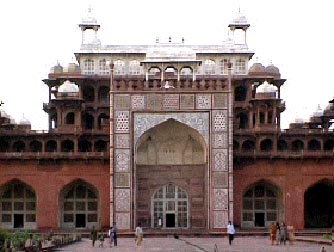 It takes more than four hours to ride from Delhi to Agra. One could travel by train but a car comes in handy for going about sightseeing as tourists. On the way we stopped at Sikandra, where Akbar is buried. The site has been cleaned and groomed but not many visitors could be seen. The grave is in a dark crypt under a large dome. A man with an oil lamp stands next to it and will coo to demonstrate an effective echo in the chamber (for a small donation). The path to the burial chamber is sloping down. I am not sure why but the urban legend is that when people walk inside they will be forced to bow their heads as if in respect (though they will actually look down so that they may not miss a step). I cannot imagine Akbar being so vain, but then the tomb was built later by his successors. However, the construction of the tomb had been started by Akbar himself while he was still alive, but after his death, son Jahangir had changed the plans in a major way. The monument is a tribute to Akbar's idea of inclusiveness, as it is an amalgam of both Hindu and Persian architecture. The multiple terrace-like architecture is reminiscent of Akbar's capital Fatepur Sikri, near Agra.
It takes more than four hours to ride from Delhi to Agra. One could travel by train but a car comes in handy for going about sightseeing as tourists. On the way we stopped at Sikandra, where Akbar is buried. The site has been cleaned and groomed but not many visitors could be seen. The grave is in a dark crypt under a large dome. A man with an oil lamp stands next to it and will coo to demonstrate an effective echo in the chamber (for a small donation). The path to the burial chamber is sloping down. I am not sure why but the urban legend is that when people walk inside they will be forced to bow their heads as if in respect (though they will actually look down so that they may not miss a step). I cannot imagine Akbar being so vain, but then the tomb was built later by his successors. However, the construction of the tomb had been started by Akbar himself while he was still alive, but after his death, son Jahangir had changed the plans in a major way. The monument is a tribute to Akbar's idea of inclusiveness, as it is an amalgam of both Hindu and Persian architecture. The multiple terrace-like architecture is reminiscent of Akbar's capital Fatepur Sikri, near Agra.
The Agra Taj Hotel where we stayed had a nice view of Taj Mahal but fog that day made visibility rather poor. However, we could not wait to see it from close quarters, and the decision to go to the Taj was made easy because we saw the sun struggling to come out from behind the clouds and fog. Knowing that tomorrow could be worse we headed straight to see the monument after lunch. The car can take you up to a parking lot and then for a fee, you ride in a battery operated (and battered) rickshaw-like vehicle to the gates of the Taj. After paying the discriminatory price for having the prefix NRI to our names, we proceeded directly to the gates of the most graceful building built by human beings.
The Taj Mahal
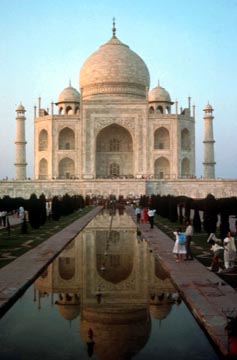 A few words of caution about the guides in these historical sites. It is difficult to find an English speaking guide, who is well versed in history and who does not try to squeeze money from you. If one is cautious about such matters, especially in Agra, one will forgo all the fun. My advice: be resigned to the fact that you are going to be fleeced, as they will smell and spot a NRI from miles away. Hopefully you don't look and feel like a naked sheep with its entire fleece sheared at the end of the trip.
A few words of caution about the guides in these historical sites. It is difficult to find an English speaking guide, who is well versed in history and who does not try to squeeze money from you. If one is cautious about such matters, especially in Agra, one will forgo all the fun. My advice: be resigned to the fact that you are going to be fleeced, as they will smell and spot a NRI from miles away. Hopefully you don't look and feel like a naked sheep with its entire fleece sheared at the end of the trip.
Now we were facing the breathtaking view of Taj Mahal through the framework of the main entrance. The guide was blabbering some history in broken English, but none of us was paying any attention to him. The Taj looked like a fragile structure, delicately placed on an open platform that you perhaps would have preferred to keep safely in your curio cabinet at home. As one approaches the Taj it seems to grow larger, until finally at close quarters the sheer size of it staggers you. The perfect symmetry of this magnificent building is only broken by the later addition of Shah Jahan's tomb, lying next to Mumtaz. He had dreamed of a mausoleum built of black marble across River Yamuna for himself, across from the Taj, but its prohibitive cost and his failing health prevented Shah Jahan from going through with the plan. The asymmetry of his tombstone next to Mumtaz in the Taj looks odd, but the sight of the two lovers side by side in their final resting place adds heartwarming romanticism to Taj. This was my fourth visit to the Taj and it still did not fail to amaze me. Now I can claim that I have seen it in all shades of light and in all types of weather.
The following day was the dreariest day of all with fog and poor visibility. We scrapped the idea of going to Fatepur Sikri - Akbar’s abandoned capital, and proceeded to the Agra Fort. Built within the confines of walls large enough to enclose a small town, the fort is impressive. Vast expanses of open spaces with gardens, palaces, Diwan-i-Am where the emperor held court (ensconced on the gorgeous peacock throne) and the living quarters, kindled our imaginations about the opulence and the grandeur of the great Mughal dynasty. One could almost hear the two daughters of Shah Jahan, Jahanara and Roshanara fussing about in their rooms with dozens of maids attending to them. Their rooms though small had a spectacular view from the open windows. They were also located in the highest part of the palace with a deep precipice outside the windows. No intruder dare pay a visit here. The architects had even made provisions for inclement weather that the plains of North India was bound to endure. The walls have receptacles were either cold or hot water could be filled depending on the season. (As our guide said, “During the cold weather they fulfilled the wall with hot water and during the summer they fulfilled them with cold water!”) The Diwan-i-Am, where the Emperor meted out justice to common folks reverberated with imaginary voices of people pleading their cases (“unjustified peoples came here to get justice”, according to our guide) in front of the Emperor seated on his throne.
In 1558, at the age of 16, Akbar shifted his government from Delhi to Agra, where he made improvements to the city, giving it water supply and drainage systems. In 1565, he began to build the Agra Fort on the site of an earlier walled fort. The new Agra Fort Complex contained a palatial-city complex, and served as the seat of imperial power for Akbar, his son and successor Jahangir, and his grandson Shah Jahan. Even after Shah Jahan shifted the capital back to Delhi in 1648, Agra continued to be an important administrative and palatial center.
In the confines of his palace Emperor Shah Jahan spent his final years, under house arrest, staring at Taj Mahal, the mausoleum of his beloved Arjuman Banu (later known as Mumtaz), at a distance on the banks of the River Yamuna. The place where Shah Jahan was imprisoned (by son Aurangzeb) is now off limits to visitors, but the loneliness of the Emperor, sitting in his room, staring at the distant Taj Mahal that he had built, is vividly imaginable A narrow stairwell leads to a small roofless terrace where the Emperor went to pray everyday. When his eyesight failed him, mirrors showing the reflection of Taj Mahal were installed in his bedroom, so the Emperor could still see the image of Taj at a closer range.

The Poignant Emperor
He spent a lifetime building a masterpiece,
The Taj Mahal became one of world's wonders.
Yet, in his waning years the Emperor found no peace,
Imprisoned by his own son, alas, what were his blunders?
A feature of Delhi and Agra monuments that struck me is that they are not ornate and gaudy, as some of the later Indian architectures tend to be. The buildings are aesthetically pleasing, symmetrical and subdued in their colors and designs, ostentatious only in their scales. Though the basic design is Persian, the Indian-ness in them is unmistakable. Renovations of these monuments are well done and the good taste is maintained throughout.
Having taken in the splendor (and given our guide a lesson or two about history), we drove back to Delhi. Mercifully, we did not see the monkey tricksters or the snake charmers on this drive, as we did not have to stop anywhere on the way back.
That night in Delhi we saw a little commotion on the roadside. When we enquired, we were told that a cow had given birth to a calf on the roadside and no one knew as to who owned the cow was. There was great concern that the calf may not survive the night without shelter as it was going to be very cold (seven degree Celsius). The guards of the nearby apartment complexes had wrapped the calf in gunny sacks and blankets but the cow was refusing to suckle the calf. We slept with a heavy heart that night but were told the next morning that both the cow and the calf had survived the night and were claimed by the owner.
We spent Christmas Eve in Delhi. We had a sumptuous dinner in a private clubhouse. It was a member's only club with a live singer (singing nostalgic Talat Mehmood ballads) and the food was unique and well presented. A small Christmas tree with weak lights stood in a lonely corner. Before long our America-born children started singing Christmas carols and infused some Christmas spirit but the crowd did not sing along. Either they felt inhibited or did not know the words for the carols (I suspect the latter). The singer unfortunately could not sing anything other than glum old Hindi songs that night. We made a quick exit before the management threw us out for causing a ruckus!
There was a good chance that we could be stranded in Delhi because of dense fog. All the flights were being delayed and since we had to connect in Mumbai to go to Mangalore, I was resigned to the fact that my itinerary was going to be turned upside down. But miraculously the fog lifted on that day and we flew out of Delhi at seven in the morning and were back in Mangalore by noon! We fared better than Mr. Atal Bihari Vajpayee, the PM of India, who was stranded in Jaipur the previous day and could not return to Delhi by air. I also read that Delhi was blanketed with fog a day later that lasted for another week. I counted my blessings.
We had safely reached Mangalore, against all odds, without any delays. A day later, we were on our way (yes, in another Toyota Qualis) to Neria, which is exactly 52 miles (you do the math in kilometers) from Mangalore. It is my ancestral village and the history of Hebbars in Neria goes back to the year 1130 A. D. The house there has seen many changes but has stood in its current location for more than 250 years. It is the only house of my growing years that I have grown attached to. During all our visits to India, the trip to Neria always is a highlight for all of us.
The rustic village setting with its rain forest, verdant valleys, the neat rows of trees of the rubber estates, and the mountains with dancing streams offer tranquil, soothing surroundings. For a city-worn tired ailing mind, the December air is remarkably salubrious. We always keep half a day for a dip in the river and nudge our heads against small waterfalls, which form as the water rushes over rocks and small boulders. The frothy water pouring over the rocks create a constant buzz in the silence of the forest.
A visit to the family temple gives me the inner peace that I cannot find anywhere else. Though we would have liked to hike the mountains, which certainly would have taken more time, we had to resort to a jeep ride to the top to see the view as well as the coffee estates. The view one gets from the top is as good as any I have seen in Western India, of rolling hills and large valleys. When we leave Neria, we always feel we have not spent enough time there. I used to get this feeling even when I used to spend my summer vacations there. With a heavy heart, we tore ourselves away from Neria and returned to Mangalore. The following poem will give you a better understanding about my feeling about Neria.
My vacations were spent in the quaint Neria village,
Surrounded by the mountains and hills of rain forest,
Where the farmers battle monsoon rains with courage,
Here I came to be rejuvenated, to relax, unwind and rest.
Hot summer days were spent cooling off in the stream,
Cooler days called for a peaceful stroll or a brisk hike,
Listening to the stillness of the forest, and its gleam,
Watching the flowers and birds, and the poses they strike.
Days well spent with introspection and forethought,
At nights, noisy crickets chirping, in my peaceful slumber.
At the crack of dawn, as the dew drops in the sunlight caught,
Came the glory of sun; the azure skies with shades of amber.
With all my worries, fears and trepidations resolved,
I reluctantly departed with my emotions churned,
To the city I went, with all my wits preserved,
Yet when seeking peace, to Neria I always returned.
However, I must say that we had a surprise entrance to Neria, when we had first arrived. A centuries-old custom of sweeping the yard with cow dung mixed in water was being carried out in full earnest. This is done in villages to control the dust rising from the yard. Once the initial smell dies down, it is an effective method of resurfacing mud yards. The America-born children of ours had cringed noses for a while till the strong aroma abated.
Our ride back to Mangalore took less than two hours on quite a bumpy road.
Back To Mangalore
Here is where we had our encounter with Rahul. A little tyke, Rahul stole our hearts in Mangalore. He is the four-year-old son of Sandhya and Kishore (My wife's sister and brother-in-law). It cannot be explained how two calm, gentle people could have given birth to this riot of a child! Rahul did not speak much but he was one continuous action-packed kid. Capricious and unpredictable, he did not sit quietly for one moment. He was into everything, vying for attention all the time. Like a flitting honeybee, impulsively he moved nimbly from one activity to another. When his mischief went a little awry or if he broke some valuable item, he simply gave his charming smile and no one would have the heart to reprimand him. He has the most innocent, angelic face with a captivating smile. The best part is that this four year old knows his asset, and makes the best use of his looks, to soften and melt adults' hearts.
Rahul, the Cool
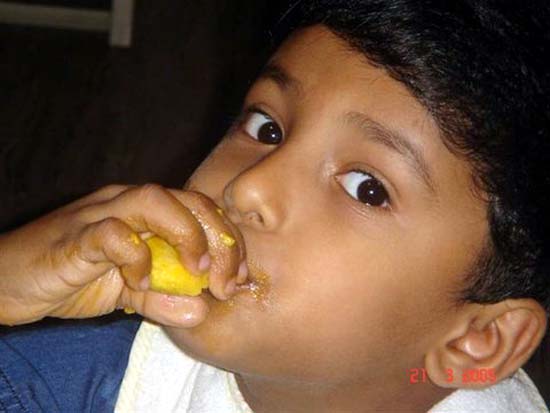
He flits, he fleets and he flies through the air,
Not an article, not a thing he will spare.
He will walk on furniture, without a care,
And always fight for his lion's share,
Until, for you, it's difficult to bear.
With his cherubic face he can win hearts, he's aware,
And when he gets in trouble, Rahul doesn't despair.
You may scorn or scold him, if you dare;
And sternly stare or try to scare,
Thinking of the rod you shall not spare.
Aha! But be forewarned and beware,
A twinkle in his eyes, a coy smile with teeth bare,
Enough to break your resolve; and a kiss he will share,
One charming look and you're hopelessly in his snare!
I have to mention about a trip we made to a training center for the mentally handicapped children while we stayed in Mangalore. It is very rare to find centers like them in India and they exist only because of the largesse of few philanthropists who not only donate money but also volunteer and spend countless hours patiently teaching and training the handicapped children. It is a noble deed and takes a special quality to be able to dedicate oneself to such honorable duties.
More and more people are now aware of its existence and send their handicapped children for help to the school. It was an emotional tour for us as we saw some determined children doing feats they had practiced with dedication and perseverance. A girl with cerebral palsy particularly impressed me with her skill of being able to thread beads with her toes. She had no use of her hands and her neck was fixed in an extended position and she could barely see the ground in front of her. Yet, she never seemed to have any doubts about her abilities. Proudly, with a smile, she showed off her skills. Many of the retarded and handicapped children (it is not a school for physically handicapped children with normal intelligence) were so happy to see us and could not contain their glee. Yet they seemed to be much disciplined and showed a lot of interest in wanting to learn the basic skills they were being taught. It was heartwarming to see the love and kindness being so openly dispensed in this school for the less fortunate segment of our society.
Beautiful Minds
Disabled and neglected, yet with a brave countenance,
She stares with imploring eyes: begging for love, and sustenance.
Her purity and beauty are transparent,
Yet to most, the encumbrance is repugnant,
No crimes are committed by these innocent children,
Still, why does society treat them as its burden?
Shortcut to Calicut
After attending some of the family get together affairs in Mangalore we drove to Calicut, a city in the Malabar Coast of Kerala. (Yes, we did hire a Toyota Qualis, again.) The drive took between five and six hours, certainly not a short drive. There are train services to Calicut from Mangalore that also take five hours but we were warned that the train was infested with cockroaches. I know my wife and daughter would rather die (or kill someone) than have an encounter with a roach. To avoid this potential criminal act, I decided to go by road. It was a good decision as the car came in handy for our transportation within the city of Calicut.
On the first evening we went to the beach where the Portuguese adventurer Vasco da Gama had first landed in India in 1498. The people seemed to be ignorant of the history of the beach or of the erstwhile adventurer called Vasco da Gama. There is not a single write up or monument at this site. It is not a very clean beach, much polluted with plastic and Styrofoam. People fully clothed in saris, salwar-kameez or long pants and shirts, were everywhere, enjoying the cool breeze. We were similarly dressed (a common garb of beach goers in India), as if we were going to a dinner party. Some of us braved to dip our ankles in water but the two kids in our group made sure their little rumps got wet. The sunset was spectacular, with the fishing boats silhouetted against the amber sky. Flocks of birds speckled the sky in perfect formation returning to their nests.
The next day we drove to the top of the mountains of Wayanad. Kerala is a beautiful green state with mountain ranges and rain forests reminiscent of Neria. We feasted on the expansive scenery and cooled off with cold beer and wine. After lunch, some of us got into paddleboats in a peaceful lake with sprinkled lotus flowers and fresh scented air. That night we had a nice New Year's Party with some Western music and dancing,.
The Return
We took the Toyota Qualis back to Mangalore in a death defying drive. I sat with my eyes closed, not merely to shield them from the blinding headlights. I was not going to be an eye witness to any poor soul getting crushed under our car.
We spent a day packing in Mangalore (no small task, I assure you). We watched some more shenanigans of Rahul, and watched the beginning of the fourth cricket test match. Sachin Tendulkar and VVS Laxman played glorious innings (India would eventually amass a massive total of 705 for 7 before declaring and the match would end in a tame draw.) A day later we boarded the plane to go to Mumbai with heavy hearts (and suitcases), after saying tearful goodbyes. We had an uneventful return to the U.S.
28-Mar-2004
More by : Dr. Neria H. Hebbar